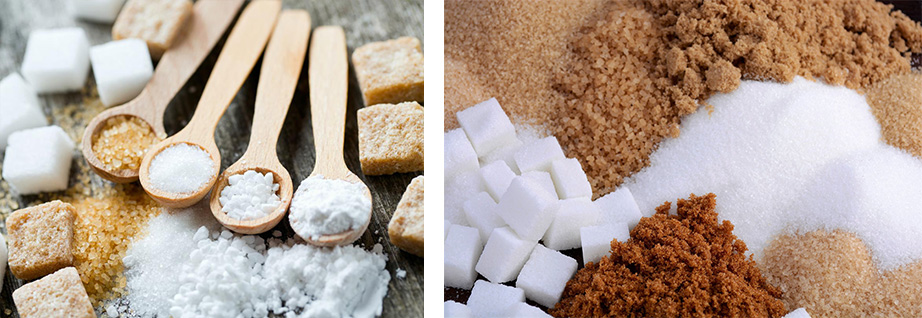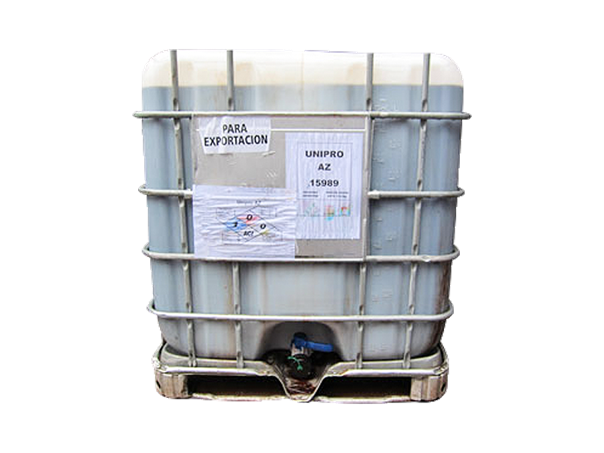UNIPRO AZ
UNIPRO AZ it’s a clarifying polymer, which is presented in solution. It’s easy to handle and present a high-grade stability.
UNIPRO AZ it’s an organic polymer of low molecular weight, and it’s essentially from vegetal origin.
Act like coagulant, agglutinative, coagulation helper and clarifying.
UNIPRO AZ has the property of catch metallic ions dissolved in the sugar cane juice, helping to reduce the values of conductivity in the water.
UNIPRO AZ act in a very low dosage, perfect for the big volumes of production in the sugar industry.

USES:
UNIPRO AZ it’s used like clarifying and help to the coagulation for the reduction of the surface in the electronic charge on the suspended solids. It must be used with high molecular weight polymers.
UNIPRO AZ actively participate in the agglomeration of the destabilized particles, promoting the formation of micro-flocks, and then in more bigger flocks, which later lay down
UNIPRO AZ it’s a color maker catcher.
BENEFITS:
-Sulphur reduction in the clarifying in a 30% - 50 % in the process of non-refined sugar production.
-Complete elimination of sulphur in the refined sugar process.
-Calcium oxide reduction in a 10 % - 30%.
-Elimination or reduction of anti-incrusting products.
-Reduction of the incrustations in the evaporators and heat exchangers.
-Elimination or reduction of the phosphoric acid consumption.
-Gradual reduction in the polymer consumption.
-More velocity of decantation, can provide a faster juice flow and a better stability in the decanters.
-Formation of a tannic I ferric complex during the milling.
-In large stops decrease the saccharose inversion in the decanter.
-In sugar mills with distillery: with regular use of the product can eliminate the formed alcohol conductivity problems.
-In rain seasons decrease the viscosity of the decreasing or removing the necessity of tense actives.
-Reduction of the POL.
-Reduction or elimination of the residual sulphite in the final sugar.
-Biodegradable product.
-Decrease of the bacterial charge.
-Reduction of the handwork.
-Reduction of equipments.
-Reduction of the energy consumption.
PHISICALS AND CHEMICALS PROPERTIES:
Appearance: Dark brown liquid
Solids contents: 40% +- 1% Ph : 1.8 — 2.2
Odor: characteristic
Molecular weight: low
Charge density: low
WAYS OF USE:
Laboratory test:
In this stage we simulate the clarifying process in a laboratory scale.
Normally this stage it’s only an indicative of which is the correct concentration that we have to use in the industrial application test and the levels of the color in the juice that we can expect. The juice characteristic and the obtained results are liable to many variables that can impact directly in the results; the most important ones are the harvest cane regions, the ground type of the harvest, the month of the year.
These factors define all the juice characteristics. Also, the damage grade of the sugar cane in the storage time, the % content of P2O5 or the type of synthetic polymer used in the precipitation, this factors can affect the results too.
For the clarifying simulation test the factors that we must take in consideration are:
- Concentration of UNIPRO AZ 80 — 200 ppm incorporated to the juice sample)
- Concentration sulphur dioxide ppm in the juice)
- Concentration of P2O5 in the juice.
- Concentration of phosphoric acid.
- pH of the juice with the calcium oxide and sulphur.
- The test must be made in an UNIPRO AZ concentration range that must be, aprox;
- between 80 — 120 ppm, depending of the variables named up. A test example;
- Procedure for the demonstrative test for the clarifying of the sugar cane juice with.
UNIPRO AZ.
1- Add to a sample of juice, with calcium oxide and sulphur 80 — 200 ppm of UNIPRO AZ with graduated pipette. Heat slowly the solution.
2- Separately, prepare a polymer solution of 0.1 % of concentration. Take a millimeter of this one, which correspond to a 2 ppm for a 500 ml volume.
3-When the solution boils add the polymer 1 ml) and stir pouring this one in a test tube of 500 ml, watch the precipitation. Wait 30 minutes after pour the solution and measure the transmittance and compare with the initial juice.
4- In the case that a good precipitation not hapen in any sample, repeat all the test increasing the amount of P2O5 adding 30 ppm more of the phosphoric acid or increasing 1 ppm more of the synthetic polymer.
5- For a lowest sulphitation simulation, dilute the initial juice sulphited like the normal factory dosage) with mixed juice, according with the reduction proposal expected; for example: for a 50 % decrease of initial sulphur, dilute with a same quantity of mixed juice and use it for repeat the test from the step 1.
Industrial test:
Once that we have determinate the best quantities of UNIPRO AZ, phosphoric acid and synthetic polymer we make the application test in the factory, in accordance with the laboratory test.
Dose the UNIPRO AZ in the dosage tank of calcium oxide after putting the juice pH in 7.2 with this oxide.
PRESENTATION:
Isocontainer of 1125 kg palletized.





